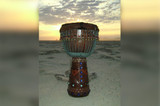Why We Love Cuban Rhythms, the Carlton Dance and Alfonso Ribeiro
In case you haven’t heard, Alfonso Ribeiro did “The Carlton” on Dancing with the Stars this week – a reprise of his famous “Fresh Prince of Bel Air” dance to Tom Jones’ “It’s Not Unusual.”As long-time fans of “The Carlton,” there is no end to the delight given to us this week.
But, we aren’t here to discuss “The Carlton,” as much as that would really be great. The show itself is a thing of beauty: creative costumes, great personalities and dancing that originates from styles that are popular the world over. It is this showcase of dance that is directly connected to rhythm, which, of course is a connection to drums, and we just can’t help notice how many Latin styles of dance are considered “ballroom” styles of dance, especially those from Cuba. We know Cuba for the drums, the rhythms, the flavor and spice of the Rumba. But dancing? Thanks to Carlton, or Alfonso Ribiero, we see the light, and we couldn’t be happier.
Cuban dance styles, like the Rumba, Salsa or the Cha-cha are guaranteed to get your feet tapping and grooving to the beat. The rhythms are sexy, fun and energetic, for the dancer and for the drummer. This connection between rhythm and dance is shared beautifully in all cultures, but, in Cuba, it’s the feel and groove of the beat and it is also the unique sound of the drums that provide the backdrop for each move on the dance floor. Cuban drums and percussion include bongo drums, bata and conga drums, all of which have a sultry, silky vibe and a pop that can be considered the essence of Cuban sound. Throw in some claves for good measure, and you have a firey mix of Cuban rhythm and sound that just can’t stop.
So, what makes these Cuban beats so great? Obviously, the drums are a big part of why we love Cuban music, but the rhythms of Cuban music are extraordinary, even when you’re just tapping along while at work. If you take the son clave rhythm, a basic rhythm in many Cuban styles of music, there is a sense of organized oddity that follows a pattern, but, not a typical 4/4 beat. With rhythm, as much as our brains may be able to relax and jive with a slow, steady 4/4 rhythm, perhaps the more erratic, if not still organized beat of the son clave 3/2 rhythm, shakes us up in a good way. More simply stated, 4/4 rhythms can create calm, and a 3/2 rhythm obviously creates energy (that is, of course, best experienced in Cuban music and dance styles, with conga drums pulling it all together!).
For any drummer or dancer who has experienced the energetic styles of music from Cuba, there is no doubt that the sounds and flair of the rhythms is what sets this genre apart from almost all other styles of music. This could be the reason why Salsa clubs are much more frequented than Foxtrot clubs, and have a better reputation for fun. Not that we don’t love a good foxtrot beat, or, its sped-up version, the Quickstep:
Whether you’re a drummer, a dancer or just a big fan of Alfonso Ribeiro and the Carlton Dance, enjoying rhythm can be more than just listening to music, it is discovering how your own feet start tapping when that Rumba starts playing, or that you just can’t get enough of Tom Jones. Whatever your own personal groove is, the lesson is clear – Be the Carlton you want to see in the world, and never let your own unique rhythm be squashed.
Oh, and, Cuban rhythms are incredible, whether watching a favorite celebrity bust 'em out on national television, at a club with friends, or even in the privacy of your own home. If you’re not already obsessed with Cuban rhythms like we are, its time to jump in and get your groove on.
Recent Posts
-
What is the Best Size Djembe for Beginners?
If you're new to the world of percussion and interested in learning the djembe, you're in for a t …16th Jul 2024 -
The Benefits of Becoming a Drumming Teacher: Transforming Passion into Profession
Why become a drumming teacher? Becoming a drumming teacher is an excellent way to share your pas …22nd May 2024 -
What Makes the Djembe Drum a Spiritual Instrument in African Music?
Origin and history of the Djembe drum The Djembe drum originates from West Africa and holds sign …16th May 2024



